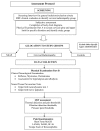An investigation of somatosensory profiles in work related upper limb disorders: a case-control observational study protocol
- PMID: 20113518
- PMCID: PMC2825226
- DOI: 10.1186/1471-2474-11-22
An investigation of somatosensory profiles in work related upper limb disorders: a case-control observational study protocol
Abstract
Background: Work related upper limb disorders constitute 45% of all occupational diseases and are a significant public health problem. A subgroup, non specific arm pain (NSAP), remains elusive in terms of understanding its pathophysiological mechanisms with its diagnosis based on the absence of specific clinical findings. One commonly proposed theory is that a neural tissue disorder is the primary dysfunction in NSAP and findings from previous studies lend some support to this theory. However, it is not clear if changes identified are simply a consequence of ongoing pain rather than due to specific neural changes. The presence of neuropathic pain has been investigated in several other musculoskeletal conditions but currently, there is no specific diagnostic tool or gold standard which permits an unequivocal diagnosis of neuropathic pain. The purpose of this study is to further describe the somatosensory profiles in patients with NSAP and to compare these profiles to a group of patients with MRI confirmed cervical radiculopathy who have been previously classified as having neuropathic pain.
Methods/design: Three groups of participants will be investigated: Groups 1 and 2 will be office workers with either NSAP or cervical radiculopathy and Group 3 will be a control group of non office workers without upper limb pain. Participants will undergo a clinical assessment, pain questionnaires (LANSS, Short Form McGill, DASH and TSK) and quantitative sensory testing comprising thermal detection and pain thresholds, vibration thresholds and pressure pain thresholds.
Discussion: The spectrum of clinically suspected neuropathic pain ranges from more obvious conditions such as trigeminal neuralgia to those with vague signs of nerve disorder such as NSAP. A thorough description of the somatosensory profiles of NSAP patients and a comparison with a more defined group of patients with evidence of neuropathic pain will help in the understanding of underlying neurophysiology in NSAP and may influence future classification and intervention studies relating to this condition.
Similar articles
-
Sensory and autonomic function in the hands of patients with non-specific arm pain (NSAP) and asymptomatic office workers.Pain. 2003 Jul;104(1-2):275-81. doi: 10.1016/s0304-3959(03)00010-1. Pain. 2003. PMID: 12855338
-
Sensory hyperalgesia is characteristic of nonspecific arm pain: a comparison with cervical radiculopathy and pain-free controls.Clin J Pain. 2013 Nov;29(11):948-56. doi: 10.1097/AJP.0b013e31827c7ae8. Clin J Pain. 2013. PMID: 23370077
-
Divergent sensory phenotypes in nonspecific arm pain: comparisons with cervical radiculopathy.Arch Phys Med Rehabil. 2015 Feb;96(2):269-75. doi: 10.1016/j.apmr.2014.09.015. Epub 2014 Oct 7. Arch Phys Med Rehabil. 2015. PMID: 25301442
-
The pain of RSI. The central issue.Aust Fam Physician. 1989 Dec;18(12):1542, 1545-7. Aust Fam Physician. 1989. PMID: 2696462 Review.
-
[Quantitative Sensory Testing in the facial area: a review].Z Evid Fortbild Qual Gesundhwes. 2013;107(4-5):291-6. doi: 10.1016/j.zefq.2013.06.002. Epub 2013 Jun 28. Z Evid Fortbild Qual Gesundhwes. 2013. PMID: 23916267 Review. German.
Cited by
-
Is pharmacologic treatment better than neural mobilization for cervicobrachial pain? A randomized clinical trial.Int J Med Sci. 2018 Mar 8;15(5):456-465. doi: 10.7150/ijms.23525. eCollection 2018. Int J Med Sci. 2018. PMID: 29559834 Free PMC article. Clinical Trial.
-
Chiropractic management of work-related upper limb disorder complicated by intraosseous ganglion cysts: a case report.J Chiropr Med. 2011 Sep;10(3):166-72. doi: 10.1016/j.jcm.2011.01.004. Epub 2011 Jun 24. J Chiropr Med. 2011. PMID: 22014905 Free PMC article.
-
Effect of manual therapy with exercise in patients with chronic cervical radiculopathy: a randomized clinical trial.Trials. 2021 Oct 18;22(1):716. doi: 10.1186/s13063-021-05690-y. Trials. 2021. PMID: 34663421 Free PMC article. Clinical Trial.
-
Are psychosocial variables, sleep characteristics or central pain processing prognostic factors for outcome following rotator cuff repair? A protocol for a prospective longitudinal cohort study.BMJ Open. 2022 Aug 4;12(8):e058803. doi: 10.1136/bmjopen-2021-058803. BMJ Open. 2022. PMID: 35926993 Free PMC article.
References
-
- Eurostat work and health in the European Union: A statistical portrait, office for official publications of the European communities. Luxemburg. 2004.
-
- Sluiter J, Rest K, Frings-Dresen M. Criteria Document for evaluating work relatedness of upper extremity musculoskeletal disorders. Scandinavian Journal of Work Environmental Health. 2001;27:1–102. - PubMed
Publication types
MeSH terms
LinkOut - more resources
Full Text Sources
Medical


